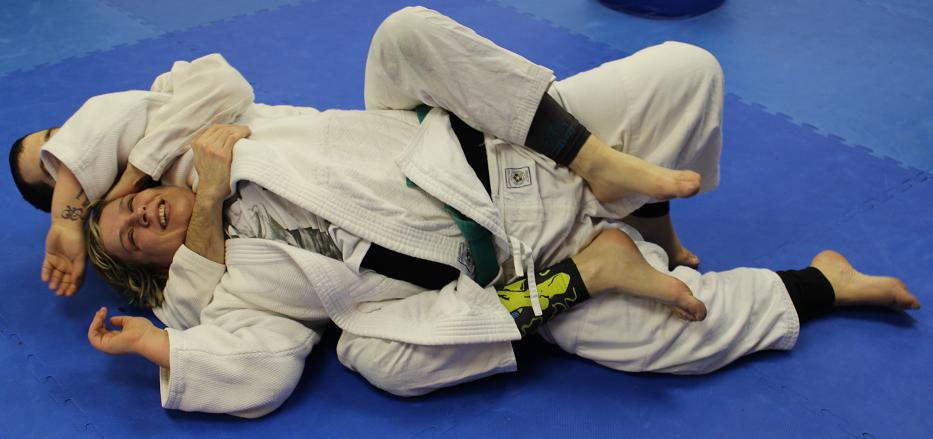Artemis BJJ (MYGYM Bristol), Can Sönmez, Bristol, UK - 03/04/2017
The back is a great position to be in. There are lots of submissions, your opponent can't easily see what you're doing, and you'll also get four points in competition (once you've got your hooks in). The first thing to note is a basic safety point, which is don't cross your feet. If you cross your feet, then all your partner has to do is cross their feet over yours and bridge, footlocking you. Instead, you want to be hooking your insteps inside their legs, or digging your heels in. The idea is to generate enough connection with your feet that when your partner rolls to one side, you will roll with them.
Second, you want to get a good grip with your arms. The harness grip (as always, various other names, like over-under and seatbelt) is a solid option for both gi and nogi. Begin by getting an arm under their same side armpit, so they can't slide down (as otherwise they can go for the scoop escape). If they have a gi, you can help secure the position by grabbing their opposite collar. The other arm comes over their shoulder.
If you can't grab a collar, then link your hands together, using that to lock yourself in place. You could also grab under both arms grabbing a collar, which is a excellent way to hold them in place. However, that means both your arms are occupied: for attacks, you have more options if you keep one arm free, to go over the shoulder.

Your arm by the shoulder is the one you'll be looking to shift into their neck and/or grabbing a collar, where you can start working for a choke. Stephan Kesting advises that rather than linking hands, you can grab your own arm, which in turn means you are blocking the best grip your opponent wants to get. As ever, play around and see what you prefer.
Third, keep your chest pressed against their upper back. To escape, they need to create space, so don't let them have any: stay glued to their upper back. This is very important, as most escapes will rely on them creating distance between your chest and their upper back. You also don't want them to put you flat on your back, like in the bridge escape, as then they can start moving their hips. If you drop back, make sure you've moved to the side. However, your ideal position is getting them face down (as long as you have your grips, otherwise it can be awkward to move into position for an attack).
Fourth, follow them with your hips, similar as when you're in their guard. If you keep moving your hips to square back up whenever they try and shift away, that again stops them creating space.
Finally, you want to keep your head locked to theirs, providing additional control. It also helps you to see what they're doing. Otherwise, their head would be blocking your line of sight. Place your head next to theirs on the armpit hand side, as that way you're controlling both sides of their skull.
I finished off with the simple way of recovering mount from the back. They've cleared one hook and managed to put their shoulders onto the mat. It will be tough to regain your back mount from here, especially if they've moved over your leg. As soon as you feel their bum move past your knee, bring your remaining hook over their body and clamp the heel to their far hip. Make sure it is providing you with enough control that they can't simply shrug you off. Pull out your elbow for base, then turn and slide through into mount, using your heel for leverage.
_____________________
Teaching Notes: I think the central thing to emphasise is gluing yourself to their upper back, keeping your head in tight too. Based on what I saw and when I spar, it seems that losing that connection is what leads to most escapes. I'll make a point of highlighting it next time. I also don't know if it's all that important to mention the following their hips thing, though it is worth noting that you never want to give them any space.
I'm still not completely happy with the format of this lesson, so I once again tried something different. This time, it was adding in that walking around option to retake the back. I think that's useful, but I don't know if it fits with the basic maintaining stuff. There's a sequence of reactions to when they escape, depending on if they get their back fully to the floor and how much they clear your legs. That's where I think it fits better. So, I could do a lesson on retaking the back, technical mount style, and maybe put this option in there, for when you have more of a connection with their back?
This basic maintenance lesson should stick with just those pointers and the shift to mount, that's enough I reckon. I'll teach it that way again next time and see how it goes, making a bigger deal of gluing yourself to their back. Some drills at the start might help, focusing on just that part: I'll need to think up a way of isolating that motion of sticking your chest to their back and head to head, then highlighting it.
No comments:
Post a Comment